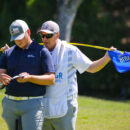Rating a U.S. Open Course: How the SCGA Rated Torrey South for the 2008 U.S. Open

The 2008 U.S. Open Championship at Torrey Pines was a special celebration of golf. It was the first U.S. Open Championship to be contested in Southern California in 60 years, and the tournament itself provided enough excitement and drama to last a lifetime.
As part of that championship celebration, the SCGA was invited to rate Torrey Pines South Course from the U.S. Open tees. That request was made by USGA President and past SCGA President Jim Vernon, because the USGA was creating an awareness program aimed at educating golfers on the multiple roles that golf associations provide for all golfers, and the rating of golf courses is one of those important roles.
Duplicating the difficult conditions of a U.S. Open golf course can be hard to visualize—unless, of course, you are asked to rate the course the Thursday before U.S. Open week, which is exactly what the SCGA was asked to do.
Course yardages are and always will be the most difficult obstacle to overcome. In 2008, the length of the U.S. Open tees measured over 7,600 yards. Although the USGA didn’t necessarily set up the course at that length, they certainly had the ability to do so. That’s quite an impressive number knowing that the course plays right at sea level. Throw in some ocean breezes along with kikuyu grass, and those tees played even longer.
The 2008 U.S. Open setup saw rough that was in the neighborhood of three to four inches in height. The rough got even longer as the ball strayed farther off target.
Fairway width can have a significant impact on ratings. During the 2008 U.S. Open, fairways averaged about 25 to 30 yards wide, compared to 30 to 40 yards during normal play. This obviously placed a premium on hitting fairways if a competitor wanted to score well and not have to contend with that deep rough, which begins just a few paces off the fairway.
Other factors that contribute significantly to ratings are the firmness, speed and contour of the greens. The greens that week certainly met the expectation for a U.S Open course. For those of you who have had the pleasure of playing Torrey Pines, you know that the greens have a lot of contour and many subtle breaks. Normal green speeds at Torrey Pines average in the neighborhood of 10’ to 11’ for everyday play, based on the use of a Stimpmeter®. During the 2008 U.S. Open, green speed averaged just over 13, which made the greens nearly impossible for us mere mortals.
Many factors were taken into account when the SCGA rated the course in 2008. As a result of our rating volunteers’ efforts, the final ratings calculated out to a course rating of 79.7 and a slope rating of 153, making them some of the highest ratings in the country.
As luck would have it, our rating volunteers actually had the opportunity to play the U.S. Open course at that rating. To say it was extremely nerve racking standing on that first tee with herds of people wondering who we were, why we were dressed the same,
(and probably incorrectly presuming we were pretty good golfers,) is a huge understatement.
The difficulty of the course that week and the validation of our rating results was clearly evident by about the fifth hole, when one of our raters hit his tee shot into the rough. After assessing
his options and deciding to make what those in his group thought would be a pretty good play, things only got worse when the ball went about 30 feet and became lost in even deeper rough.
With another 200 yards added to the ‘tips’ since 2008, pushing the course past 7,800 yards, we would expect even higher ratings for this year’s U.S. Open, and we can’t wait to watch another celebration in June to see how it all plays out.










